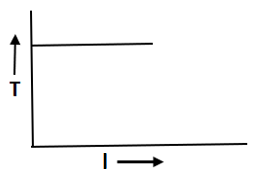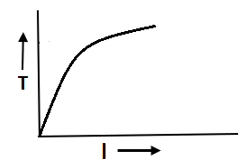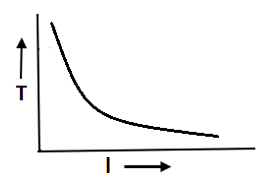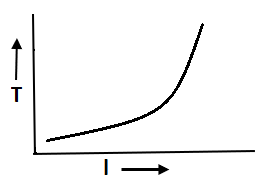
In case of a simple pendulum, time period versus length is depicted by
A. 
B. 
C. 
D. 
Answer
219k+ views
Hint:In a simple pendulum the time period is defined as the time taken to complete one oscillation by the bob attached to the string. The time period is depending only on the length of the pendulum. By using the relation between the time period and the length of the pendulum we can easily draw the graph between them.
Formula used:
The time period (T) of a simple pendulum is given as,
\[T = 2\pi \sqrt {\dfrac{l}{g}} \]
where l is the length of a simple pendulum and g is the acceleration due to gravity.
Complete step by step solution:
For a simple pendulum, time period is given as
\[T = 2\pi \sqrt {\dfrac{l}{g}} \]
From this equation, we get the relation between time period(T) and the length (l) of the simple pendulum.
\[T \propto \sqrt l \]
\[\therefore {T^2} \propto l\]
Here the time period is directly proportional to the square root of the length of a simple pendulum. It means if the time period increases then length will also increase. So, the graph of time period versus length shown must show increments of both.
Hence option B is the correct answer.
Note: The simple pendulum is a system which moves in an oscillatory motion. The simple pendulum exhibits simple harmonic motion (or SHM) in which the acceleration (a) of the bob of a pendulum is directly proportional to the displacement(x) from the mean position and it is always directed towards it. The time period (T)of the simple pendulum is dependent on the length of the pendulum and independent of the amplitude of oscillation.
Formula used:
The time period (T) of a simple pendulum is given as,
\[T = 2\pi \sqrt {\dfrac{l}{g}} \]
where l is the length of a simple pendulum and g is the acceleration due to gravity.
Complete step by step solution:
For a simple pendulum, time period is given as
\[T = 2\pi \sqrt {\dfrac{l}{g}} \]
From this equation, we get the relation between time period(T) and the length (l) of the simple pendulum.
\[T \propto \sqrt l \]
\[\therefore {T^2} \propto l\]
Here the time period is directly proportional to the square root of the length of a simple pendulum. It means if the time period increases then length will also increase. So, the graph of time period versus length shown must show increments of both.
Hence option B is the correct answer.
Note: The simple pendulum is a system which moves in an oscillatory motion. The simple pendulum exhibits simple harmonic motion (or SHM) in which the acceleration (a) of the bob of a pendulum is directly proportional to the displacement(x) from the mean position and it is always directed towards it. The time period (T)of the simple pendulum is dependent on the length of the pendulum and independent of the amplitude of oscillation.
Recently Updated Pages
Two discs which are rotating about their respective class 11 physics JEE_Main

A ladder rests against a frictionless vertical wall class 11 physics JEE_Main

Two simple pendulums of lengths 1 m and 16 m respectively class 11 physics JEE_Main

The slopes of isothermal and adiabatic curves are related class 11 physics JEE_Main

A trolly falling freely on an inclined plane as shown class 11 physics JEE_Main

The masses M1 and M2M2 M1 are released from rest Using class 11 physics JEE_Main

Trending doubts
JEE Main 2026: Application Form Open, Exam Dates, Syllabus, Eligibility & Question Papers

Understanding Uniform Acceleration in Physics

Derivation of Equation of Trajectory Explained for Students

Hybridisation in Chemistry – Concept, Types & Applications

Understanding the Angle of Deviation in a Prism

Understanding Collisions: Types and Examples for Students

Other Pages
JEE Advanced Marks vs Ranks 2025: Understanding Category-wise Qualifying Marks and Previous Year Cut-offs

Units And Measurements Class 11 Physics Chapter 1 CBSE Notes - 2025-26

NCERT Solutions For Class 11 Physics Chapter 8 Mechanical Properties Of Solids

Motion in a Straight Line Class 11 Physics Chapter 2 CBSE Notes - 2025-26

NCERT Solutions for Class 11 Physics Chapter 7 Gravitation 2025-26

Understanding Atomic Structure for Beginners




